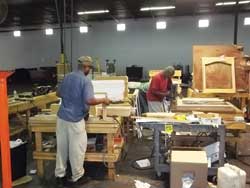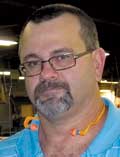
Standard Furniture production employees in Bay Minette, Ala., are at work in a cell area that assembles mirrors.
BAY MINETTE, Ala. -- Case goods manufacturer Standard Furniture could have shifted to an all-import model and walked away from the challenges of running a domestic factory.
Instead, it took those challenges head on and decided to keep its plants in Bay Minette and nearby Frisco City, Ala., open.
The plants in southwest Alabama produce roughly 35% of Standard's volume, a significant figure considering
that Asian imports represent the upper end of the company's line. Frisco City and Bay Minette produce promotional to lower middle priced laminate bedrooms - $349 to $499 four piece sets in Frisco Bay and $599 to $999 sets in Bay Minette - placing them in the good and better part of the company's good-better-best story.
But in a global economy where success often is based on low-cost labor, maintaining these operations has not been easy.
To keep them running, the company made tough choices, including reducing headcount and redesigning of the plant floors. The moves increased efficiency by lowering labor costs.
 Todd Evans
Todd Evans
 Thomas Caskey
Thomas Caskey
In the early 2000s, labor represented roughly 15% to 18% of the wholesale cost of finished goods. That high figure was largely overshadowed by the high volume flowing through each factory during a booming economy.
"From 2000 to 2005, we were running at maximum capacity in both facilities," said Todd Evans, president. "Then we lost some focus and efficiencies in the plants. We didn't focus on innovating our processes. And with labor running at 15-18%, you can't be competitive."
Evans said these inefficiencies came into sharper focus as the economy - and orders - began to wane, in effect making it more difficult to hide high labor costs.
"We could not have sustained our two manufacturing operations," he said, estimating that in China, labor represents only about 8% of finished goods costs. "If we didn't address our labor efficiencies, imports would have put us out of business."
So around 2008, Standard hired consultant Lean Pathways to help reconfigure its manufacturing processes.
This began with the 450,000-square-foot Frisco City plant, which is about 50 miles northeast of the larger Bay Minette operation. The company reconfigured its production from a linear to a more cellular system, where employees focus on specific tasks such as the assembly of mirrors and bed frames.
"The biggest inefficiency we had in that plant was the configuration of equipment as it relates to the production process," Evans said. "We stripped the equipment in the whole factory and we were able to reconfigure the equipment into the natural work flow. Materials and each step of the manufacturing process were configured with that. It eliminates a lot of movement waste, which is labor."
With a simpler manufacturing process, the company can better achieve standardization of various components and also can make furniture in smaller lot sizes versus the larger production runs seen when the economy was booming, officials said.
The changes have resulted in fewer employees - about 600 now, down from a peak of 1,200 in 2007. About 200 of them work in Frisco City and the remainder in Bay Minette.
Despite the painful choices involved in shedding workers, the changes had almost immediate results at Frisco City, where labor was reduced to 10% of product costs in the first year.
"We became believers fast," Evans said.
Now the company has begun to duplicate the process at its one million-square-foot Bay Minette plant, which in midsummer was running at about 70% capacity.
Overseeing the shift is Thomas Caskey, vice president of manufacturing, who has been with the company since 1999. He said the company went live with its first revamped production line at Bay Minette on April 15, and the project is expected to be completed later this year.
"The Frisco plant is the model of what we are trying to accomplish here," he said, adding that Bay Minette was originally tailored to 1,500- to 2,000-piece runs versus the more typical 250 seen today. "The assembly process here will resemble Frisco City to a tee."
With Frisco City running at 100% capacity, Evans now said it is his job to find ways to fill the extra capacity of the Bay Minette plant. So far, he is optimistic, based on 2012 sales projections, which are on track to be 17% ahead of the company's 2011 sales of $149 million.
While this is still below its estimated $272 million in sales in 2005, Evans said the company has a more efficient structure, which he said positions it well for future growth.
"At the time, the demand was tremendous, and I look at today's numbers in terms of what true demand is," he said. "Now we have the capacity to meet the demand we had at the peak. The efficiency is much greater."
For a longer version of this story and additional photos, see the Sept. 10 print issue of Furniture/Today.





